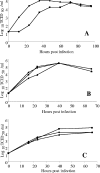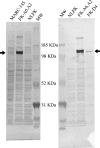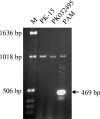CD163 expression confers susceptibility to porcine reproductive and respiratory syndrome viruses
- PMID: 17494075
- PMCID: PMC1933360
- DOI: 10.1128/JVI.00513-07
CD163 expression confers susceptibility to porcine reproductive and respiratory syndrome viruses
Abstract
Direct functional screening of a cDNA expression library derived from primary porcine alveolar macrophages (PAM) revealed that CD163 is capable of conferring a porcine reproductive and respiratory syndrome virus (PRRSV)-permissive phenotype when introduced into nonpermissive cells. Transient-transfection experiments showed that full-length CD163 cDNAs from PAM, human U937 cells (histiocytic lymphoma), African green monkey kidney cells (MARC-145 and Vero), primary mouse peritoneal macrophages, and canine DH82 (histocytosis) cells encode functional virus receptors. In contrast, CD163 splice variants without the C-terminal transmembrane anchor domain do not provide PRRSV receptor function. We established several stable cell lines expressing CD163 cDNAs from pig, human, and monkey, using porcine kidney (PK 032495), feline kidney (NLFK), or baby hamster kidney (BHK-21) as the parental cell lines. These stable cell lines were susceptible to PRRSV infection and yielded high titers of progeny virus. Cell lines were phenotypically stable over 80 cell passages, and PRRSV could be serially passed at least 60 times, yielding in excess of 10(5) 50% tissue culture infective doses/ml.
Figures








References
-
- Cavanagh, D. 1997. Nidovirales: a new order comprising Coronaviridae and Arteriviridae. Arch. Virol. 142:629-633. - PubMed
-
- Delputte, P. L., S. Costers, and H. J. Nauwynck. 2005. Analysis of porcine reproductive and respiratory syndrome virus attachment and internalization: distinctive roles for heparin sulfate and sialoadhesin. J. Gen. Virol. 86:1441-1445. - PubMed
-
- Duan, X., H. J. Nauwynck, and M. B. Pensaert. 1997. Virus quantification and identification of cellular targets in the lungs and lymphoid tissues of pigs at different time intervals after inoculation with porcine reproductive and respiratory syndrome virus. Vet. Microbiol. 56:9-19. - PubMed
Publication types
MeSH terms
Substances
LinkOut - more resources
Full Text Sources
Other Literature Sources
Research Materials
Miscellaneous

